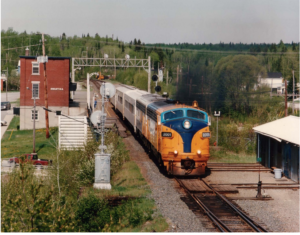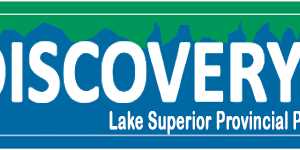
Obsolete and worn out when they were converted in the early 1990s from barebones GO commuter coaches to faux intercity cars, some of this 55-year-old rolling stock recently a $50-million second touch-up and gallons of blue paint for the Cochrane-Moosonee Polar Bear Express. This weary equipment is seen here in 1997 on the old Northlander at the Swastika station, which the ONR demolished in March 2021. Photo by Arnold Mooney
My friends! The Northlander will return!
I know that for a fact, my friends, because politicians on the re-election campaign trail are right now promising to give us a new, bigger, better and much improved Northlander … if… re-elected.
On the other hand, whenever I hear politicians doling out that “my friends” syrup, I check to see if my wallet is still in my jacket pocket. I do the same each time I hear yet another promise of the Northlander’s imminent return. Their circus train “test runs” are the toppers in the field of hocus pocus stunts. Each of these showboating exercises has made rail professionals howl with laughter at their technical pointlessness. But advertising sells, eh?
This political and public Northlander fixation is really over the top now. Sorry to say, but the Northlander was not and never will be the most vital train in Ontario. A Toronto-North Bay-Timmins train – or is it now a Toronto-North Bay-Cochrane train with a branch to Kirkland Lake? – is doomed from the start. The desperate and disparate crumbs of information being handed out by the pols confirm that. They haven’t the faintest idea of what they’re doing or what they’re promising to do
A single daytime train using exhausted and exhausting 55-year-old ex-GO Transit commuter cars, running less than daily on trackage less than half owned by the ONR, will be unappealing to passengers. It won’t attract the ridership to justify its high costs.
Furthermore, no one ever mentions that the ONR’s own deteriorated trackage is in the midst of being upgraded after years of neglect just to handle its slight and slow freight business. This deterioration is the result of the game playing that has gone on at the ONTC for decades. It started even before the Harris government threatened to privatize it and then ignored its needs after retreating on the sell-off idea because of the impact on their re-electability north of the French River.
Canadian National’s privately-owned Newmarket Subdivision from Washago to North Bay will also need a slightly smaller stack of public greenbacks to bring it up to a standard that can handle passenger trains fast enough and frequent enough to lure passengers out of their cars or the competing ONTC buses on the publicly-funded highways.
Keep in mind that any train between Toronto and Washago has to use CN’s very busy Bala Subdivision, a keystone in its booming Western Transcontinental Main Line (freight). VIA’s Toronto-Vancouver Canadian has a devil of a time getting over this 90-mile track segment most days because of the sheer volume and length of all the high-revenue freight trains. This is compounded by the lack of a sufficient number of sidings long enough to accommodate them when they meet the opposing Canadian. The passengers wind up on the sidings waiting for these huge freight trains to go by.
This complication is a major one and the ONTC knows it. When I drew a line in the sand with one of their now-retired executives, who seemed to be playing games with me on information I required for the Northeast Lynx plan, he came clean in an email response. It contained this reference to the problems in operating any passenger trains on CN south of North Bay:
“A train between Toronto and North Bay might get decent ridership if it runs daily, at the right times of the day, and if transit time could consistently remain below 5 hours. Not having control of any of the line south of North Bay makes me very wary (reference your email on the Canadian today)…. The efforts and daily distractions involved in running passenger trains are considerable. I know, because we were still running the Northlander the last time I was at the ONR.”
This and the other problems the politicians and their pals constantly dodge can all be solved, but not without lots of time and public money. But instead of even ‘fessing up to these massive challenges, we get an endless stream of feel-good photo-ops involving test trains using those old GO commuter cars. Replacing the seats and slathering them in blue paint doesn’t make them suitable for what the promoters try to fob off as a modern and effective rail service.
Then, there are those ONTC and Metrolinx studies that are supposed to reassure us. This government dropped $5 million on one that was, hmmm, light on evidence, to say the least. Now, another $75 million has been pledged to this ongoing trainload of consultation and study, more low-speed test runs and heaven knows what else. We don’t know because no one in authority will tell us.
Stepping back from this runaway trainload of errors and exaggerations, you have to ask if it’s worth it for a train that has been gone for a decade, had marginal ridership near the end of its life and which wouldn’t address the most useful existing routes in Northern Ontario.
Those are VIA’s transcontinental Canadian on the CN mainline through Capreol, Longlac and Sioux Lookout, and the stubby remains of the pre-1990 service provided through Sudbury, Schreiber and Thunder Bay by the original Canadian. This remainder of the service long provided on Canadian Pacific’s North Shore main line is now VIA’s tri-weekly Sudbury-White River train. It is operated with soon-to-expire Budd rail diesel cars, accurately labelled Dayliners when CP bought them in the 1950s.
VIA’s Canadian is also facing big equipment problems because the sturdy Budd stainless steel cars introduced by CP in 1955 are finally wearing out after a highly successful rebuilding program in the early 1990s.
The Canadian and the Dayliner, and what could be done with them to improve their usefulness and assure their continuation, are much more important issues than a revived Northlander. These trains serve larger markets with more ridership potential on two well-maintained Class I railways. Large portions of their routes have no bus, air or even highway alternatives, unlike the proposed Northlander Redux. Alas, my friends, I’m compelled to sign off on the Northlander issue. Sadly, my prediction is that the Polar Bear Express will still be the only passenger train on ONR rails when Ontarians go to the polls in 2026.
Now, about the Canadian and the Dayliner, my friends….
- A Northlander Fix or Fixation? Part 1 - May 5, 2022
- A Northlander Fix or Fixation? Part 2 - May 5, 2022
- The ACR’s Future – Sale or Abandonment? - January 16, 2021
 Wawa-news.com You can't hear the 'big picture'!
Wawa-news.com You can't hear the 'big picture'!

